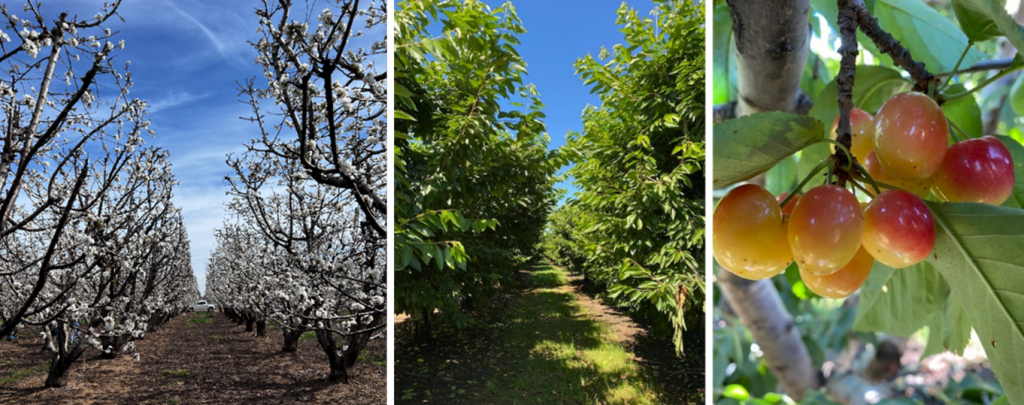Note: This is part of a Research Update series that highlights projects funded by the California Department of Food and Agriculture’s (CDFA) Fertilizer Research and Education Program (FREP) annual grant program.
Project Title: Development of Nutrient Budget and Nutrient Demand Model for Nitrogen Management in Cherry
Project Leader(s):
- Patrick Brown, Professor, Department of Plant Sciences, University of California, Davis
- Douglas Amaral, Cooperative Extension Advisor, University of California Division of Agriculture and Natural Resources
- Ricardo Camargo, Staff Research Associate, Department of Plant Sciences, University of California, Davis
Project Status: Completed 2023
Project Location: San Joaquin County

Overview
Often the last trees to bloom and the first to harvest each season, California sweet cherry growers have a short window to make nitrogen (N) management decisions and in-season adjustments. Historically, cherry growers have utilized leaf sampling and critical values to manage N. While these tools can be useful for diagnosing a deficiency, alternate approaches may offer a better means for managing fertilization in this high value crop. In this project, the team collected measurements from three highly productive cherry groves to improve N fertilizer management tools available to California growers.
Key Takeaways
This project demonstrated that fertilizer use in mature California cherry groves can be optimized if N applications are adjusted based on tree demand and seasonal uptake patterns.
- Tree Demand: N demand was determined to be an average of 2.59 lbs. per 1000 lbs. of harvested fruit plus an average of 28.3 lbs. per acre for perennial tissue growth and maintenance.
- Seasonal Uptake Patterns: Starting approx. 30 days after bloom, N uptake from the soil occurs rapidly through the fruit development and vegetative growth stages with up to 90% of uptake occurring by September.
Project Results and Discussion
Tree N Demand
For tree crops, the total N requirement for the season can be estimated by multiplying expected yield by a crop removal coefficient (i.e., the amount of N removed from the field with harvested fruit). The results are then divided by the expected N use efficiency (NUE).
- Total N = (Expected yield x N Removal Coefficient) ÷ NUE
Some mature tree crops, like cherries, require an additional amount of N for perennial tissue growth. This amount is typically between 10-40 lbs. of N per acre.
- Total N = [(Expected yield x N Removal Coefficient) + N for Perennial Growth] ÷ NUE
In this project, whole cherry trees were sampled and excavated to determine the N removal coefficient and the additional nitrogen required for perennial tissue growth. These values can be used by California cherry growers to estimate N fertilizer requirements for the season.
| Variety | N Removal Coefficient (lbs. N/1000 lbs. of fresh fruits) |
| Rainier | 2.74 |
| Coral | 2.73 |
| Bing | 2.32 |
| Weighted Average | 2.59 |
| Variety | N for Perennial Growth (lbs. N/acre) |
| Rainier | 28.99 |
| Coral | 28.41 |
| Bing | 27.51 |
| Weighted Average | 28.30 |
“Right Rate”: To increase N efficiency, N fertilizer applications should be based on the estimated N requirement minus N available from other sources such as irrigation water and organic amendments.
Seasonal Uptake Patterns
This project demonstrated that from November to February the amount of N present in the tree canopy remained relatively stable suggesting that the growth of leaves, stems and fine roots is dependent on N stored in perennial organs. Nitrogen uptake from the soil begins 20-30 days after full bloom and continues to increase rapidly through September. After late October, no significant N uptake from the soil was observed.

“Right Time”: To increase N efficiency, N fertilizer and organic amendment applications should be timed to ensure that N will be available to the plant during periods of high N uptake.
Project Impact
The results from this project show promise in setting new standards for N management across the cherry industry. Project leaders demonstrated that fertilizer use in cherry cultivars can be optimized and considerable N losses can be reduced if applications are synchronized with the tree demand and seasonal uptake patterns. This information is being shared with growers through the Cherry Board of California and the University of California Fruit and Nuts website.
To learn more about this project and other current and completed FREP projects please visit: https://www.cdfa.ca.gov/is/ffldrs/frep/Research.html


